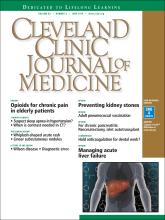Article Figures & Data
Tables
Coronary artery disease Chronic kidney disease and end-stage kidney disease Bone disorders and fractures Aortic calcification Hypertension Type 2 diabetes mellitus Gout Metabolic syndrome Sarcoidosis Renal tubular acidosis Bowel disease and intestinal surgery Renal and bladder anatomic anomalies Medications Genetic abnormalities DIETARY INTERVENTIONS All—Increase fluid intake to produce a urine volume of at least 2.5 L/day Calcium stones and hypercalciuria—Limit sodium intake to 2,300 mg/day; consume at least 1,000 or 1,200 mg/day of dietary calcium; restrict nondairy animal protein to 0.8 to 1 g/kg/day; increase intake of fresh fruits and vegetables Calcium oxalate stones and relatively high urinary oxalate intake—Limit intake of oxalate-rich foods and maintain normal calcium intake Calcium oxalate stones and hypocitraturia—Increase intake of fruits and vegetables and limit nondairy animal protein Uric acid stones or calcium stones with hyperuricosuria—Limit intake of nondairy animal protein to 0.8 to 1 g/kg/day Cystine stones—Limit sodium intake to 2,300 mg/day and protein intake to 0.8–1g/kg/day PHARMACOLOGIC INTERVENTIONS Hypercalciuria and recurrent calcium stones—Thiazide diuretics Recurrent calcium stones and hypocitraturia—Potassium citrate Uric acid and cystine stones—Potassium citrate to alkalize urine to optimal level Recurrent calcium oxalate stones and hyperuricosuria— Allopurinol Uric acid stones—Do not use allopurinol as first-line therapy, but consider it in refractory cases Type 1 hyperoxaluria—Pyridoxine Cystine stones unresponsive to conservative measures— Offer a cystine-binding thiol drug, eg, D-penicillamine or tiopronin. Pharmacotherapy should always be used in conjunction with conservative measures of dietary modification and urinary alkalization Residual or recurrent struvite stones, and surgical interventions are contraindicated or refused—Consider urease inhibitors, acetohydroxamic acid






